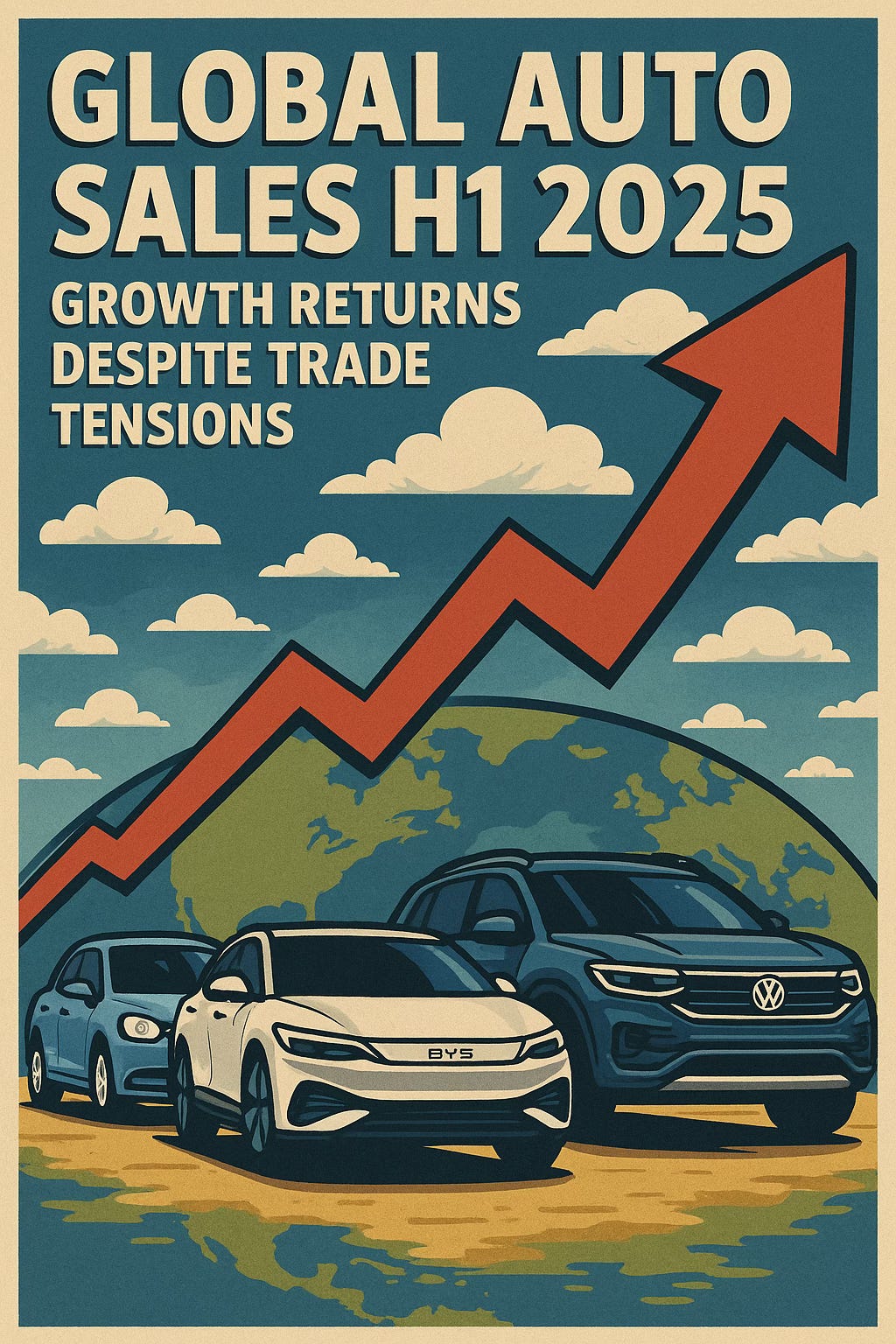Global Auto Sales H1 2025: Growth Returns Despite Trade Tensions (UPDATED)
By Rafael Benavente
Global Auto Sales H1 2025: Growth Returns Despite Trade Tensions
The first half of 2025 has surprised many analysts: global vehicle sales are up by 3.5% year-over-year, totaling approximately 42 to 45 million units. This growth comes amid a backdrop of geopolitical uncertainty, tightening tariffs, and EV market volatility.
What explains this resurgence? And what does it mean for automakers navigating a fast-changing global landscape?
📊 YoY Snapshot: 2025 vs. 2024
RegionH1 2025 SalesH1 2024 SalesYoY ChangeGlobal~42–45 million~40.7 million+3.5%United States~6.67 million~6.2 million+7.5%China~13.2 million~13.0 million+1.7%EU~6.1 million~5.9 million+3.0%
Despite rising protectionism and high interest rates, most major markets posted year-over-year gains.
🚗 What’s Driving the Growth?
1. Inventory Recovery and Backlog Fulfillment
After years of supply chain constraints, chip shortages, and pandemic-related factory shutdowns, vehicle inventories have normalized across most markets. Automakers are finally delivering on backorders, especially for high-demand SUVs and pickups.
2. Electric Vehicle Momentum
Global EV sales hit 9.1 million units in H1 2025, up 28% year-over-year. Countries with strong incentives (Germany, Norway, China) and growing charging infrastructure are pushing adoption.
3. Fleet Replacements Postponed Since COVID
Rental companies, commercial fleets, and even private owners delayed purchases during 2020–2022. That pent-up demand is now working through the system.
4. Aggressive Discounting and Financing
Automakers, especially Chinese EV brands like BYD and Geely, are cutting prices and offering aggressive financing, absorbing tariffs and taxes to maintain global volume.
5. Stabilized Inflation and Consumer Confidence
Though still elevated, inflation has cooled in key markets. Combined with falling interest rates in the U.S. and EU, consumers are regaining confidence in big-ticket purchases.
6. Strong Product Launch Cycles
Major automakers like Toyota, Hyundai, and Ford introduced high-volume models (both ICE and EV) in late 2024, hitting showrooms in early 2025. The strong lineup across SUV, crossover, and hybrid segments is drawing buyers back.
7. Regional Manufacturing Expansion
To mitigate tariff impacts, companies are accelerating local production (e.g., BYD in Hungary, Hyundai in Indonesia, GM in Mexico), allowing them to serve regional markets without cross-border penalty costs.
🌐 Tariffs, Trade Wars, and the China Factor
While tariffs on Chinese EVs have risen in the U.S. and are under review in the EU, they haven’t yet dented total volume. Why?
Chinese automakers are redirecting exports to Latin America, Southeast Asia, and Eastern Europe.
Final assembly outside China (e.g., BYD’s Hungary plant) is helping avoid tariffs.
Price-cutting and cost absorption by Chinese firms have kept EVs affordable even with added duties.
That said, trade tension remains a wild card for the second half of 2025.
📈 Brand Winners in H1 2025
RankBrandEst. Sales (M)Notes1Toyota~4.8Global leader, strong hybrid mix2Volkswagen~2.4Resurgent in EU, expanding EVs3Ford~1.9F-Series and Explorer growth4BYD~1.15Top EV brand, global expansion5–7GM, Hyundai, Honda~1.5–2.0Battling for 5th place globally
🌟 Notable Brand Standouts
Toyota continues to dominate globally with a balanced portfolio and strong hybrid sales.
BYD is the standout EV performer, entering new markets while growing volumes 40%+ YoY.
Volkswagen has regained momentum in Europe, helped by new ID-series EVs and plug-in hybrids.
Ford gained traction with refreshed truck and SUV models, especially in North America.
Geely and Chery (China) posted double-digit global growth, expanding in Southeast Asia and Latin America.
🔮 Outlook for H2 2025
Sales may slow in the second half as interest rate cuts taper off and tariff actions intensify.
EV market will remain volatile, especially if battery prices rise again.
Automakers will double down on regional production, especially in Europe and Southeast Asia, to hedge trade risk.
Still, the first half suggests a resilient, if uneven, recovery in the global auto sector.
📊 Conclusion: A Rebound with Caveats
H1 2025 has been better than expected. Vehicle production has stabilized, EV growth remains strong, and global demand is holding up. But the outlook remains clouded by tariffs, inflation risk, and election-year policy shifts in major economies.
For now, though, the auto industry is accelerating out of its post-pandemic slump — with cautious optimism and an eye on geopolitical risk.
By Rafael Benavente

